Sven Libaek's Autobiography | Read more at in70mm.com The 70mm Newsletter |
| Written by: Sven Libaek. Reprinted with permission. Thanks to Anders M. Olsson, Sweden for making the text ready for publication. | Date: 10.09.2011 |
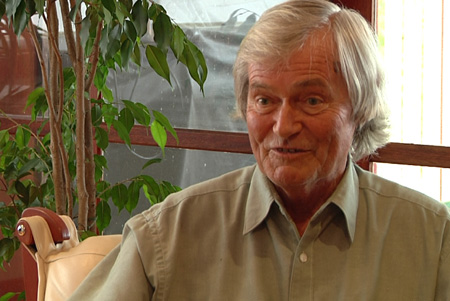 Sven Libaek
in Australia 2011. Image by Richard Monk, from "Behind the Scenes of Windjammer" by
Dave Strohmaier Sven Libaek
in Australia 2011. Image by Richard Monk, from "Behind the Scenes of Windjammer" by
Dave StrohmaierWhen American Film Producer Louis de Rochemont came to Norway in 1956 to make arrangements for using the Norwegian square rigger Christian Radich as the star of his next project, he was on top of his game. His series "March of Time" and documentary "Fighting Lady", (about an aircraft carrier), were both Oscar winners. He had a reputation for turning up new and fresh talent, and for starting new trends. Lauren Bacall, Charles Coburn and Dorothy McGuire portrayed roles before his camera and then achieved stardom in Hollywood. Karl Malden, ("Boomerang"), Mel Ferrer, ("Lost Boundaries") and Ernest Borgnine, ("The Whistle at Eaton Falls"), all actors with good stage experience, were introduced to movie audiences through the films of Louis de Rochemont. While he was a producer for 20th Century Fox, he started the movement to "location shooting" (with "House on 92nd Street"), thereby adding to the reality of the movies. Thus accustomed to taking on new projects and unknown quantities, it is not surprising that he would strive to realise on the new Cinemiracle screen the adventure-filled voyage that is "Windjammer". | More in 70mm reading: "Windjammer" in Cinemiracle Composer & Movie Star Sven Libaek interviewed for "Windjammer" DVD/BR release Movie Star Visits Copenhagen "Windjammer" Cast & Crew Interviews in Oslo "Windjammer" Director Passes Away Internet link: |
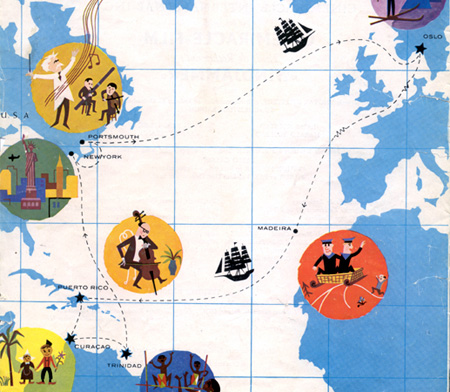 The
route of the Christian Radich. Illustration from Danish souvenir program The
route of the Christian Radich. Illustration from Danish souvenir programChristian Radich, (a training ship for the merchant marine in Norway), was to sail on a nine months cruise, first through the English Channel to the island of Madeira. Then across the Atlantic Ocean, visiting several islands in the Caribbean and ending up in Key West, Florida. From there the ship would sail up the East Coast of the USA, stopping in New York City and then further north to Portsmouth, New Hampshire. From there it would head back to Norway across the top of Scotland. All through this magnificent trip there would be a camera crew on board with their monster Cinemiracle camera. The ships crew would consist of the usual training cadets and officers, but Louis also wanted a few Norwegian actors who the camera could follow throughout the trip. Although the film was basically a travelogue, there would be some studio shots and lines to be learned and lots of music to be sung and played. |
11.09.2011 The "Windjammer Story" written by Sven Libaek on your web-site is very impressive. He wrote the report with great effort and much love. Also very interesting are his narrations concerning the film-music by Morton Gould. Many thanks to Mr Libaek for his work. Nice Sunday and greetings... Gerhard Witte, Berlin, Germany |
|
I had recently finished the Norwegian film "Nothing but Trouble" mentioned
earlier, and I jumped at the chance of meeting de Rochemont and put my name
down as one of the actors he was looking for. The fact that I was also a
pianist, more or less ready to make my debut as a concert pianist in Oslo,
made a positive reaction on Louis. None of us knew what he was about to do
about my piano skills, but I got the part in Windjammer, and everything that
has happened to me in my career from that moment on has been as a result of
"Windjammer". A piano was bought and chained to the bulkhead of the sailing
ship so that I could practise during the voyage, (which made my parents
happy) I was 16 years old, and was about to set out on the adventure of a
lifetime. It was to be a career move that was to determine my entire future
to this day, and one, because of my age at the time, I could not have
accepted without my parent's permission. | |
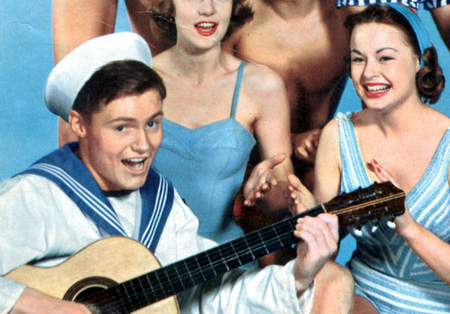 Sven
Libaek in a publicity shot for "Windjammer" Sven
Libaek in a publicity shot for "Windjammer"The Windjammer cruise of Christian Radich and the filming of "Windjammer" need a book all by its own, certainly more than a chapter in an autobiography. For the 17 officers and men and 85 young boys, this would be a voyage of such a unique nature that nobody else would ever have a similar experience. We all have our memories and highlights of the trip, and this "Windjammer" chapter covers mine. Under dark, grey, snow-laden skies on December 8th, 1956 our ship nosed out into the cold waters of the Osfofjord. It only took a couple of days before we, the 5 "so called actors" realised that we would have to become part of the regular crew, or probably be tossed overboard at some future stage. Our adult real actor, Lasse Kolstad was to play the part of a ship's officer and he immediately started learning the ropes. Harald practically over night started a ship's newspaper, and the rest of us were up in the rigging from word go. I still remember my first climb up to the main royal sail. The main mast was 180 feet tall, and the royal is the top of five sails on the mast, so the yardarm servicing it would be over 150 feet from the deck. When you looked down from this height, the ship looked very small, almost to the point of you thinking that, if you fell, you would miss the deck all together. That was not the case, of course, but I am happy to say that during the 9 months voyage, we had no major accidents on board. We flew through the English Channel at 18 knots with all sails set, passing lots of other ships. It was a great thrill, and we felt very superior. Nothing wrong with the old sailing ships. On the 11th day we entered the Bay of Biscay, and the fun was over. As we prepared to celebrate Christmas, we were hit with a major storm that quickly turned into a gale. Almost everyone got seasick, which is truly a horrible thing to suffer from, but I guess you could say we got it over early in the voyage. Apart from some officers and more seasoned sailors, the one living creature on board that did not get sick, was our ship's mascot, our dog Stomp. He would stay next to the helmsman on the bridge and sway against the waves, never loosing his footage. He was a sight to be seen and had become a true sailor. Some things I guess you don't have to train a dog to do. Everything below deck, which was not properly secured, was sliding around crazily. I remember helping to clean up after a barrel of marmalade had turned over and mixed with a barrel of salted herring, and of course a fair bit of vomit from the guys cleaning it up. During the days of the storm, which seemed to last for ever, our ship, with all sails secured and red storm lanterns displayed to notify other ships that we could not manoeuvre, lay wallowing in mountainous waves - often being blown back over 20 miles a day. These were some of the most miserable days I have ever known. The great French ocean liner Ile de France was forced back to port by the storm we had weathered. The glamorous job of acting in a Hollywood movie had disappeared as quickly as it occurred. We had become real windjammers less than two weeks into the voyage. The only filming that took place during this first stage of the trip was with a regular 35mm movie camera. Thank God the huge Cinemiracle camera was not on board, because who knows what would have happened to it. As we kept sailing south towards the island of Madeira, the weather slowly changed, and all of a sudden it became warm, like spring weather in Norway. Per Johnson, one of the other young "actors" started climbing up the foremast shrouds with a red bundle under his arm. I followed him up to the royal yard. When we reached the top, he loosened the bundle - it was his long red underwear - and he let it float out into the sea. Everyone on deck cheered. Per and I looked towards the horizon and we could see our first landfall, Madeira. From this distance, we saw just a mountain sticking out of the ocean and into a cloud. Everyone climbed the rigging to have a look. Zarco, the Portuguese explorer saw the island in 1419 and he couldn't have been happier than we were at that moment. The next day we would feel solid ground under our feet again in Funchal. | |
 The
Cinemiracle camera and Thomas Conroy. Image from Richard Babish The
Cinemiracle camera and Thomas Conroy. Image from Richard BabishWhen we docked, we were met by Louis de Rochemont and the complete Cinemiracle camera crew, including our director, Bill Colleran. I didn't know much about Bill, but I knew he had some serious credits to his name in The US. What I did find out immediately was that he was married to the talented and beautiful actress, Lee Remick. That night at the hotel, Louis had arranged for us to put on a show in the dining room. Talk about short notice. Lasse and Harald were good singers, and Per played the drums. I was on piano of course. It was great thrill playing a grand piano after weeks at sea, practising on an upright, lashed to the bulkhead. I can't remember what we put together and how we pulled if off, but it was a huge success. Louis celebrated by opening a bottle of champagne for us all to share, and I had my first taste of Don Perignon. Yes, don't get your knickers in a knot. I know I was underage by today's Australian standards, but fortunately Europe is not so uptight about it. And, surprise, surprise, it didn't turn me into an alcoholic as an adult. | |
|
Madeira was our first location shoot with the Cinemiracle camera and we
loved it. Being in a foreign country, (other than a Scandinavian country)
was something new to most of us. Madeira is a beautiful island, and the feel
of the whole place was so different to Norway. Not to mention the warm
breezes, which Norwegians long for most of the year back home. Getting used
to the huge camera and all the planning that had to go into each and every
shot was time consuming but interesting. One of the highlights of the
Madeira sequence in the film was the ride on the famous basket sleds. It
became a most thrilling scene in the movie, thanks to the triple camera that
filmed the action. To the future audiences it would be like actually riding
the sleds themselves. The film crew of 19 also moved the camera on board and
started looking into the many problems of filming on board a sailing ship at
sea. Our next port of call was to be San Juan, Puerto Rico, and during the
long crossing of the Atlantic "on board" filming was to take place. We left Madeira, following the route Columbus took in 1492. We soon entered the Trade Winds, and the trip as a whole was very pleasant compared to what we had been going through on the way to Madeira. We had quiet days when we could do maintenance, scrub the teak decks, fix ropes in the rigging and repair sails "blown out" during the Bay of Biscay gale. The living quarters of the boys in the crew were quite ingenious. All of us slept in one big area below deck, (no luxury here.) However, we all slept in hammocks. When you think of it, this is truly a brilliant arrangement. A sailing ship is frequently moving between the port or starboard tacks. In a cabin with a bunk, you would either lie flat against the wall, or, suddenly as the ship went about, struggle not to fall out of bed. In a hammock you hung straight all the time and it was easy to sleep in all weather conditions as soon as you got used to it. The officers all had proper cabins, but I really think the boys were better off - except for no privacy of course. The "boys toilet" was another story all together. It was popularly referred to as "the 10 seater". And that was what it was. Basically a plank with 10 holes in it and a channel underneath to catch the crap. The plank was running along the bulkhead, so here we definitely had the "bunk problem". When the ship was under sail, you sat on the toilet, either practically lying down with your back against the side of the ship, or you were fighting not to fall forward, off the seat and bang into the other side of this delightful little room. 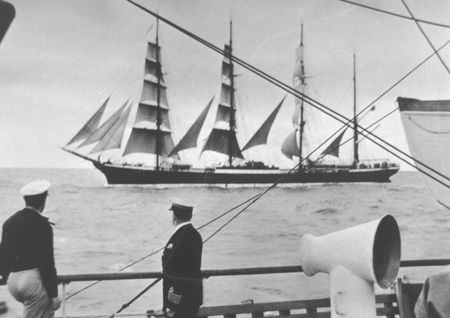 Passing
the Pamir in mid Atlantic. Publicity still from the film. Passing
the Pamir in mid Atlantic. Publicity still from the film. The trip across the Atlantic was fairly uneventful except for one unbelievable chance meeting. I was standing stern lookout on the poop deck just a couple of days out of Funchal, when I saw what looked like the top gallants and upper topsail of what must be another sailing ship. One of the other boys climbed the rigging and could see her black hull. It was the German four-mast bark Pamir. She was altering course and sailing towards us. None of our officers, or the captain, had ever experienced a chance encounter with another Windjammer in open waters. We sailed side by side for several minutes, shouting greetings to each other. She was on her way to Montevideo, Uruguay. What made this meeting at sea of historic significance to us all was that, before our own windjammer cruise was over, we found out that the Pamir had gone down in a hurricane in the North Atlantic with all but six of her crew. Her captain had tried to race across the hurricane's face to get on the right side of it and keep his big ship safe. He almost got away with it, but it proved to be a costly mistake. Pamir would have been better off hove to, like we had been during the Bay of Biscay gale. Water got inside her, and once that happened, the ship was doomed. It took the greater part of a dreadful day for the big school-ship to slide under the sea, and the crew fought till the end. Only six young boys survived and were rescued by searching vessels after many days adrift in a broken lifeboat. We always thought of ourselves as unsinkable after passing our early "test", but I am sure the trip would not have been quite as enjoyable if we had heard of the Pamir incident early in the piece. | |
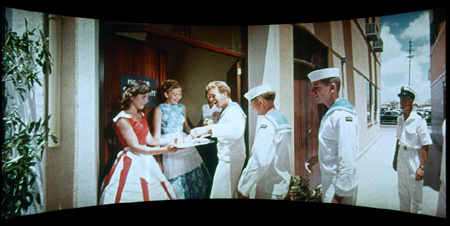 Image
from the film. Cinerama Inc Image
from the film. Cinerama IncWe had many scary moments ourselves. One was about to happen as we entered the harbour in San Juan, Puerto Rice. We always wanted to sail into a new port whenever possible. A square rigger under full sail is a beautiful sight, and would get our film cruise great publicity. However, on this occasion a sudden wind change almost sent us on the rocks. We managed to do a quick tack just in time, and to the hundreds of people watching from the shore and the dock, it looked like a perfectly planned "entry". Little did they know how close we had been to disaster. On this Atlantic crossing the first filming was done at sea with the huge Cinemiracle camera. They even managed to figure out a way of hoisting it up the mast to take birdseye shots of the ship from above. The main problem the camera crew had was the fact that with the enormous screen, future audiences would actually feel that they were at sea. How could they make sure that members of the audience would not get seasick? | |
 Image
from the film. Cinerama Inc Image
from the film. Cinerama IncWe had a great time in Puerto Rico. It was our first contact with the Americans, (other than the camera crew), and there were invitations and parties all over the place. Louis de Rochemont and Associates had already been negotiating with the US Navy to involve them in the film for an "old and the new" type segment. We spent many a pleasant moment at the US Naval Base in San Juan, discussing the many aspects of the sea. They were all a great bunch of guys. We were also invited to a reception at the Governor's Palace Fortaleza. In this beautiful location we filmed a special performance by the legendary cellist Pablo Casals. Louis was planning many important musical sequences in the film, but he hadn't yet mentioned what he had in store for me. We filmed all over the city and got some great shots of this beautiful island, including the then famous flamingos at Caribe Hilton. Having gotten the "touch and go" entry to the city out of the way, everything else during our stay went smoothly and to plan. There was one small incident which happened one night when the Bosun of the ship, and myself, were walking down a rather dark street a bit out from the main drag. We were being followed rather too closely by a couple of unsavoury looking characters. The Bosun, being a powerful looking chap, "took the bull by the horn". He turned around suddenly, faced them and said "can I help you?" The two guys mumbled something in Spanish and took off in a hurry. I have often thought subsequently that they were probably totally OK and only took off because they thought we might rob them. I really enjoyed my stay in Puerto Rico. It was my first visit to a Caribbean island. The climate was wonderful, the beaches breathtaking, the people friendly and helpful. Don't forget, we were looking at it all with northern European eyes, and I somehow knew right there and then that I would eventually end up in a warm climate place. What I didn't know of course, at the time, was that years later I would marry a girl with a Puerto Rican background. There are many strange coincidences in life. | |
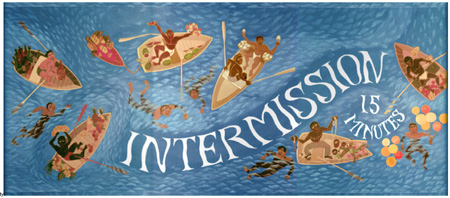 Intermission
title card from the film. Cinerama Inc Intermission
title card from the film. Cinerama IncFor the next two months we cruised around in the Carribean, filming on many famous and exotic islands. We were stranded on St. Thomas in the Virgin Islands for almost a month of this time. Some major changes to the production and the production team was in the works, and Louis did not discuss these problems with us "sailor/actors." Mind you, it wasn't a bad place to be stuck for a while. Lee Remick delighted all the men and boys on the ship by flying down from Hollywood to spend some time with her husband, our director Bill Colleran. We took a side trip in one of the longboats to a place called Salt Island where we went skin diving. It had some of the clearest and cleanest water in the world, and it was fascinating to be able to see for what seemed like kilometres under water. The marine life on the reefs was spectacular. We had one scary moment involving Lee. She was the last person in the water, swimming towards the boat, when we noticed a shark fin not too far behind her. The worst thing we could do was scream out and cause her to panic. Bill kept his cool and called out, "come on - hurry up, we got to be going back". We pulled her into the boat with a few meters to spare. She turned very pale when we pointed out what had been swimming behind her. The island of St. Thomas, in the past, used to belong to Denmark. Some of the older natives still spoke Danish and it was a curious sight having a blond Norwegian and a black Carribean islander sitting together talking Danish. The main town on the island was Charlotte Amalie. It had many nightspots to entertain sailors and tourists. We used to frequent one in particular where they had a really nice jazz pianist. Per and I did our piano and drums bit there on the occasional night for free drinks. One night we walked in and the pianist was playing all this really catchy music which we had never heard before. We asked him if it was his own compositions, and he said: "I wish...." My Fair Lady had just opened on Broadway, and he had gotten hold of some of the music, and that was what we were listening to. Little did I know that a few days later I would be sitting in the Broadway theatre attending that very musical. | |
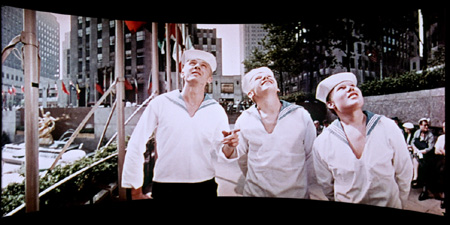 Image
from the film. Cinerama Inc Image
from the film. Cinerama IncThree weeks without any filming and seeming to go nowhere, Louis invited us five "actors" up to his hotel room. He explained that they were in the middle of changing aspects of the film and future places to visit. In the meantime he had decided that he would fly two of us to New York, so that we could have a look at some of the rushes of the filming done so far. We had to decide between the five of us, which two were to go. We decided just to draw lots. Harald and I won the trip. To get to New York from St. Thomas back then, we first had to take a "local" shuttle flight to Caracas, Venezuela. This was an old DC3 and in fact was the exact island hop flight you see in old movies. The passengers consisted of a calf, three dogs, and several women carrying cages with chickens, fruit and vegies, plus two Windjammers. The one pilot was a tall, dark, handsome and beautifully uniformed Venezuelan. The airport in Caracas had more armed soldiers in it than passengers. Another coup in progress no doubt. They used to have them regularly back then. However, we were soon on the flight to New York without incident. | |
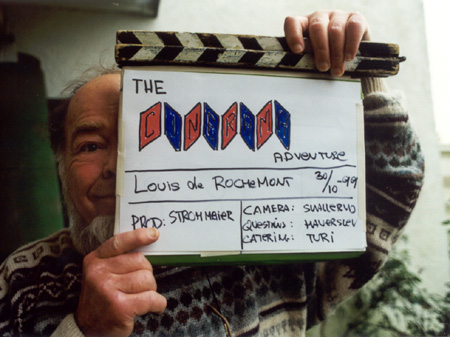 Louis de Rochemont in Oslo October 30, 1999
during production of "Cinerama Adventure". Picture by Thomas Hauerslev Louis de Rochemont in Oslo October 30, 1999
during production of "Cinerama Adventure". Picture by Thomas Hauerslev My first impression of New York was instant love. We stayed in a hotel on Madison Avenue, close to the head office of Louis de Rochemont and Associates. If I remember right, it was now late March or early April. Anyway, it was still cool in NY. I found out something very interesting about my body. I had stored up so much heat from the weeks in the West Indies, that I honestly didn't feel the colder weather. People used to look at me because I walked the streets in short armed shirts while New Yorkers were still bundled up. We were "in town" for only one week, and the highlights were of course seeing "Windjammer" rushes. It was fantastic. We had never seen a screen this big, and the shots at sea were spectacular. We certainly had something to tell the rest of the ship's crew on our return to St. Thomas. So did they us. We had only been gone a short time, but big changes had occurred. Bill Coleran was no longer our director. We never did find out if he resigned or was fired. Anyway, he and Lee had gone. Louis de Rochemont III, son of our producer was taking over. It was not a popular choice. We had nicknamed him "little Louis" quite early in the piece, and looked at him as a bit of a bumbling fool and a daddy's boy. Of course, as usual, we were totally wrong. Little Louis did a great job with the rest of the film and he and I remained friends, and stayed in touch until the day he passed away. He eventually moved to Norway after falling madly in love with a beautiful Norwegian girl, Turi. Their love story would make the love stories in "An Affair to Remember" or "Sleepless in Seattle", look tame in comparison. | |
 Impression
of the film on a deeply curved screen Impression
of the film on a deeply curved screenHowever, back to "Windjammer". Things were now happening again in a hurry. The sails were set, and off we went to cruise other film locations in the West Indies. We were "on the road again", or should I say more correctly, "at sea again". We had two major locations left to film in the Carribean, and of course the sailing between them. One of them was Trinidad. Calypso music was very popular back then. Harry Belafonte was on top of his career, and everyone was fascinated by steel drums, and the sound they produced. Trinidad became a musical event for all of us. Although some of the Calypso numbers were written for the film by Terry Gilkyson and the Easy Riders, native musicians, singers and dancers performed them with a spontaneity which appeared to be inspirations of the moment. We arrived just in time for the Carnival in Port-of-Spain, and had a ball. We also filmed the famous limbo dancing where tall natives would bend backwards and go under a bar that would be as close as a foot or so above ground. It was amazing stuff and made for a great sequence in the film. Another Trinidad sequence was the annual cutting and harvesting of the sugar cane, a major Trinidad export. Naturally this sequence was also backed by another calypso song. The other location was the Dutch island of Curacao. It was a great contrast to Trinidad in that it was much more European. Captain Kjelstrup was about as good as those ancient Vikings who could tell their position by the colour of the water. He dead reckoning brought us right close to Curacao" harbour. Sailing up the "main street" we could almost talk to the Dutch on either side of the channel. They were very exited about seeing a windjammer. Curacao was fun. Those Dutch girls were charming and many brief relationships occurred. We enjoyed a rijstuffel, a sort of large picnic on an old estate. Our ships mascot Stump also went on liberty - unofficial that is. I don't know how he managed to escape, but he proved he was a real sea dog by rejoining us. I know he met "a friend" in Willemstad. He was sitting on the poop deck looking back, longingly as we sailed away from the island. His whiskers had been flattened back by the wind for so long that they now grew that way. | |
We were now on our way to the United States and our first port of call was
to be Key West on the southern tip of Florida. The Florida Keys were to
become one of my five favourite places in the world. However, on the way
there I, and the rest of the crew, had a fright. I was standing look-out in
the bow of the ship one beautiful sunny day. We had standard signals we had
to give the helmsman if we saw something. One bell for something to
starboard, two bells for something to port and three bells for something
dead ahead. I just happened to be looking down, and I saw the bottom.
Sailing ships are not only moving forward by the wind, but because of the
constant pressure of the wind on the sails from one side or another, also
over time, can drift a considerable distance sideways. We had drifted over
the Bahama Grounds. There were no "bells" for seeing the bottom, so I ran up
on the bridge and warned the captain. Nobody else had noticed it yet. We
immediately went about, but for more than an hour we just waited for the
"crash" of our keel hitting and grounding us. We were very lucky as it
didn't happen. The rest of the trip to Key West was not totally uneventful.
One day some of the boys coming off watch swore they could see neon lights
from the American shore. There was one startling light we could see for
sure. After sundown we noticed a strange grouping of very bright stars. It
was in fact a large comet that the radio had said would be visible in our
latitude. There it was, suspended in space, apparently motionless - but we
knew it to be roaring through space with a fiery tail extending hundreds of
thousands of miles behind it.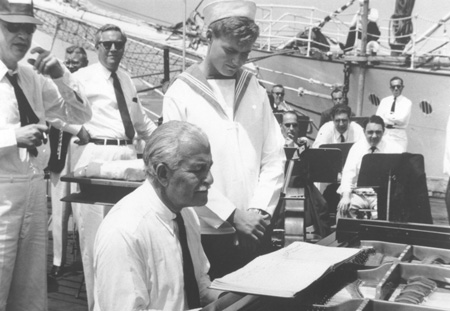 Arthur
Fiedler and Sven Libaek on the pier playing the piano. Still from the
film Arthur
Fiedler and Sven Libaek on the pier playing the piano. Still from the
filmIn Key West Louis de Rochemont came on board and "sprung the bombshell". The quote as nearly as I can remember it, went something like this: "I have arranged for you to play the Grieg A minor Piano Concerto with the Boston Pops Orchestra under the baton of its conductor Arthur Fiedler. We will make it a major sequence in the film. We will film the performance and then use some of it as background music for beautiful scenes of the fjords and mountains of Norway. I have also arranged for you to work with a famous pianist in New York to bring you up to speed, so it's time for you to really start practising." I was a stunned 17 year old. Sure I had studied the piano since I was 5. Sure I had a piano on board which I had practised on "now and then", but in no way was I prepared for this type of performance with one of the world's most famous symphony orchestras and conductors. However, I had no choice. The cost of all this was enormous, and the deal had already been made. The piano lashed to the bulkhead became my home during the trip from Key West to New York. I had to pull this off or make a total fool of myself in front of a hundred professional musicians, not to mention the film crew and everyone associated with the production of "Windjammer". When I sat down at the old upright for the first time after getting the news, both my hands and legs were shaking. The music that resulted was nowhere as good as it had been a week earlier. It was scary stuff, and the first time I had experienced real "performance nerves", so common among classical soloists. Like with sports stars, you have to learn to control those nerves, but that takes years. | |
Christian Radich entering New York harbour under full sails was an event
that New Yorkers would never forget. We were met by hundreds of pleasure
crafts, and the fire department was out in their vessels, spraying water
into the air with their hoses. We docked at New York's Battery and hundreds
of people came down to visit the ship. The New York segment was shot by
WEEGEE who had developed some magic lenses. It showed New York in a way that
had never been seen before. It was a fantasy impression of the world's
greatest city on the world's biggest screen. These were some of the first
"special effects" ever developed. Nowadays it's hard to find a film without
them. We had a song about it in the film called Village of New York. It had
lyrics like: "In the Village of New York - they say the buildings grow so
tall they push away the sky" and "They never dim the lights along the Great
White Way and when the day is done, the Midnight Sun comes out like in
Norway". I missed most of the fun in New York this time as I was "stuck" in
the studio of pianist Bernardo Segal, preparing for my first appearance with
a symphony orchestra. He had me practising 8 hours a day and gave me many
tips that have stayed with me all through my musical career. I felt pretty
good after the few weeks I spent with him. The ship was off again, shooting
a large segment with the US navy - the old against the new. One of the most
amazing shots in the entire film took place in this segment. They strapped
the camera to the front of a submarine and filmed as it surfaced. It was
spectacular because the first thing you saw when the sub emerged was
Christian Radich under full sail. It became even more spectacular when
Morton Gould added his music to the scene. How they managed to plan that
shot is a mystery to me to this day.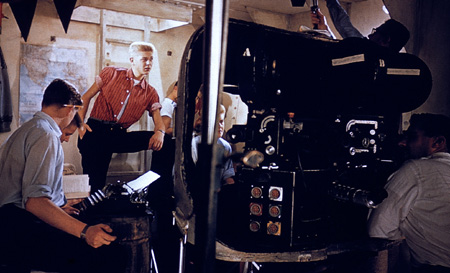 Studio
filming in New York. Image from Robert Weisgerber Studio
filming in New York. Image from Robert WeisgerberWhile the boys had all the fun working with the US Navy, I flew to Boston to meet with Arthur Fiedler and The Boston Pops. I played the first movement of the Grieg Concerto for him, and after making a few pointers, he agreed it was good enough to record. We went into Boston Symphony Hall and recorded it. I have certainly heard better interpretation of the Grieg, but I was pretty happy with my performance. I thought they were going to film in Boston Symphony Hall, but they flew the entire orchestra, Fiedler and me to Portsmouth, New Hampshire where we set up on the dock with the ship in the background, and filmed to playback. In the film you see the opening section of the Concerto being played on the dock, and then the cameras move to Norway, showing some of the most incredible shots of the country that we had ever seen. It became the highlight of "Windjammer", and set me on a musical career with interest in acting dropping by 25%, although not quite yet dead all together. | |
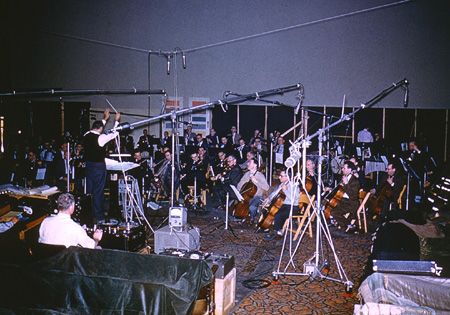 Recording
the symphonic soundtrack in New York. Image from Robert Weisgerber Recording
the symphonic soundtrack in New York. Image from Robert WeisgerberThe filming, as far as we were concerned, was now over. While the camera crew flew to Norway to film the magnificent scenes I described above, we sailed back to Oslo, going north of Scotland. 237 days after departing we could see the lights of Norway, and on the next day we were met by two other sailing ships, the Danish "Denmark" and our own "Sørlandet" and the three of us sailed into Oslo harbour together. It must have been quite a sight. We had experienced an adventure so unique that we knew it was something that would never again be repeated. We all thought that was the end of it. Little did we know. I had missed the last year of high school, so I went back to studying hard. I was allowed to take all the final exams as a private student, and I passed. "Windjammer" was now in postproduction and I was waiting for the news that the film had opened in Hollywood. Instead I got a call from Louis de Rochemont telling me that I, together with another five boys and Lasse, were required in New York for studio shots to tie the "Windjammer" cruise and story together. I didn't know it at the time of course, but this time I left Norway for good - except for future visits. The studio shots required dialogue, (in English, of course) and the film company sent us to a New York drama coach, Claudia Franck, who was famous for her work with many Broadway starts, and film stars like Sal Mineo. She got us into shape, but later on would be even more influential in the way my life turned out. | |
 Mixing
the soundtrack in New York. Image from Robert Weisgerber Mixing
the soundtrack in New York. Image from Robert WeisgerberWith the filming all completed, Harald, Kaare and I decided to remain in the United States to further our advanced education in our chosen fields. Harald was to study drama at Yale, Kaare studying business at Dartmouth, and me trying to get accepted into Juilliard School of Music. Being interested in music, I was invited by the film company to attend the recording sessions for the background music to "Windjammer". Morton Gould composed the magnificent score, and it was my first experience at a movie scoring session. It was thrilling, and I knew right away that this was what I wanted to do with my life. Morton was scoring "to the film". The orchestra was placed in front of an enormous screen, and the music was recorded while the film was playing in the background, so you knew immediately how it was going to work. A stripe moved across the screen from left to right, and when it hit the end, the music cue started. The Cinemiracle Symphony Orchestra was conducted by Jack Shaindlin. Jack had a long and successful association with both Morton Gould and Louis de Rochemont. For a number of years he was musical director for "March of Time", and for some years also the musical director for 20th Century-Fox Films. | |
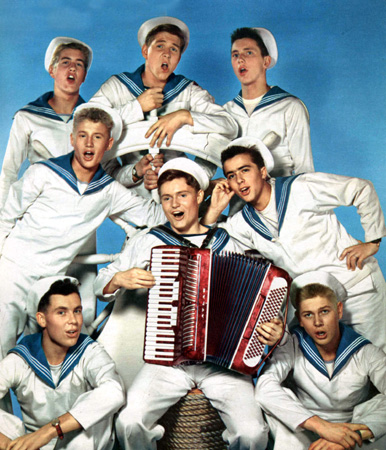 Publicity
still of the Norwegian boys in "Windjammer". Publicity
still of the Norwegian boys in "Windjammer".At the first recording session for "Windjammer", the orchestra had pre-planed pulling a dirty on him. As the stripe moved across the film for the opening titles, Jack had his baton raised and ready. When the moment came, Jack gave a significantly strong down beat - and, nobody played, followed by a lot of laughter, maybe not from Jack. This never happened to me in my career, so it must be a New York thing. The "Windjammer" adventure had just started for Harald, Kaare and me. When the film was ready to open worldwide, the film company re-hired us to travel around and promote the film and attend opening nights. We decided to form a singing trio so we could do more than just talk on all the radio and television shows we were invited on. Kaare and I played guitar, and I quickly arranged several songs for the three of us. The Kingston Trio was very big at the time, and I based our arrangements on their sound, although we included, for obvious reasons, sea shanties and the like. The world premiere of the movie took place at the famous Grauman's Chinese Theatre in Hollywood. Louis had hired a well known PR man to take us around. His name was Van Wolfe, and his most recent claim to fame was working with Mike Todd on "Around the World in 80 Days". Van was a Hollywood "insider" and knew more about the film industry and it's stars than we could ever dream of. He told us about Marilyn Monroe's involvement with the Kennedys long before it became common knowledge. The four of us headed for the Hollywood opening on the famous "Superchief" train from New York, via Chicago to Los Angeles. What a way to see America for the first time. We stayed in glamorous first class cabins with all the trimmings. Just out of Chicago, Van told us that there was a lady in a cabin near us, who had heard about "Windjammer" and wanted to meet us. The next moment we are sitting there having coffee with Rita Hayworth. Unbelievable stuff. She got off the train in Pasadena to avoid the mob at Union Station in Los Angeles. The press had found out that she was on the train, and dozens of reporters and photographers were there waiting - and we thought they were there for us. Van Wolfe was talking up the film wherever we went. You would think he was talking about "Gone with the Wind". I asked him one day what he really thought about it, and he said, "I haven't seen it". We were stunned. He explained that he didn't want to see it, because if he did, and didn't like it, he couldn't sell it. It sort of made sense I guess, but all this was so new to us that we had no idea of the ins and outs of "the business". | |
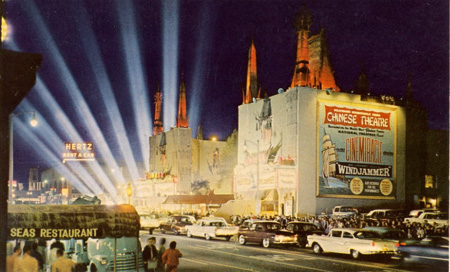 Hollywood
premiere at the Egyptian. Contemporary postcard Hollywood
premiere at the Egyptian. Contemporary postcardThe world premiere was a typical Hollywood event, and there we were, three young Norwegian boys, who a year earlier could only have dreamt about attending such a spectacle. "Windjammer" received a plaque in the forecourt of the theatre among all the famous hand and foot prints of the stars. It was fun to re-visit the place many years later when I lived in Los Angeles for 17 years. The film next opened at the Roxy Theatre in New York, then the European premiere in Oslo, Norway, followed by London. Our newly formed "singing trio" The Windjammers attended all these openings. One thing that had started to annoy me was, that because of my performance of the Grieg in the film, I was constantly asked to play the piano. With all this travelling I didn't have time to practise much, so I was very reluctant to do it. I used to try and find excuses for saying "no" in a polite way, not to upset some important people. We had a big reception at the Norwegian Embassy in London, and of course I was asked again. I told them I was happy to do it, but I had found throughout my travels that a lot of pianos I was asked to play on hadn't been tuned for years. They immediately changed the subject, and I was not asked again. | |
|
The Oslo opening was special. After all, this was a film about a Norwegian
sailing ship, manned by Norwegian sailors. Also the spectacular sequence of
Norway during the Grieg Concerto performance made a big splash. The whole
Royal family attended and it was an evening to remember for all of us
forever. The three of us had to return to the US to attend our different colleges, so we missed some of the other European openings, but our trips were not over and done with. Practically every weekend and holiday we all gathered together again. We attended openings in Chicago, Pitsbourgh, Cincinnati, Detroit, Montreal, Oklahoma City and many others. This many years later, they are a bit of a blur. I remember talking a girl home on the train in Chicago after a date in minus 20 degrees, too cold even for a Norwegian. The most memorable US trip was to Oklahoma City. We spent a whole summer vacation there, which coincided with the premiere of "Windjammer". This is where The Windjammers became a really professional trio. Practically every day we entertained at Rotary, Kiwanies and Lions Club luncheons. (I have had a hard time eating chicken ever since). We were "discovered" by a local PR man, Bobby Boyd, and he arranged for us to get a recording contract with RCA Victor. They flew us to Nashville, where we recorded and album produced by Chet Atkins and John D. Loudermilk. We performed on the Grand Ol Opry and other TV and radio shows. The Windjammers had become recording artists. 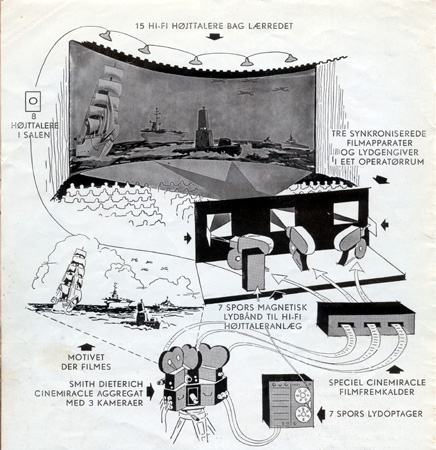 Cinemiracle
layout. Three cameras, three films and three projectors, plus the soundtrack
and the illusion of reality is complete Cinemiracle
layout. Three cameras, three films and three projectors, plus the soundtrack
and the illusion of reality is completeAlthough Cinemiracle is a triple camera and projection system, it is difficult to realise while viewing Cinemiracle's huge curved projection screen that three projectors are actually doing such a precision job. The blending or vignetting of the three projected panels, the perfect registration and steadiness without vibration, the even distribution of screen illumination, the good definition and clarity were responsible for making Cinemiracle a perfected wide-screen process. In the theatres, three specifically designed projectors were electrically interlocked with a seven channel sound reproducer in a single compact projection room at the rear of the auditorium. Cinemiracle's projection had a great depth of focus without the blur characteristic of other wide-screen processes at the time. This eliminated eyestrain for the viewer. It was, (and still is), truly a remarkable cinematic experience to watch this process in action. By the time you have watched Windjammer, more than nine miles of picture film will have travelled through the three electrically interlocked projectors. "Windjammer", the film, with it's spectacular screen size and audience participation, was an instant success everywhere it played. In Norway alone, with a population of 4 million, 500,000 people went to see it. | |
| Go: back - top - back issues - news index Updated 22-01-25 |
